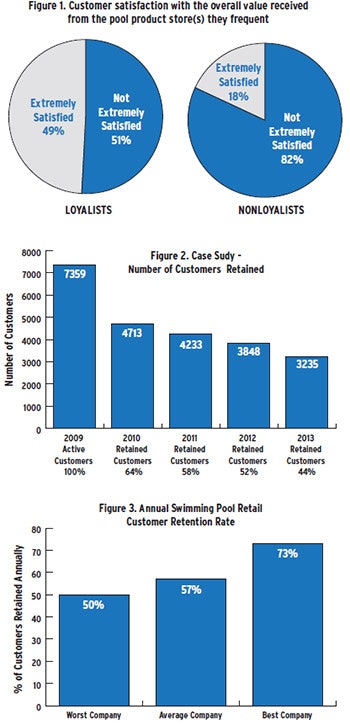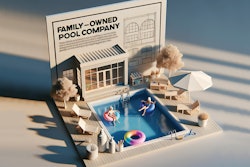
After his successful series of articles last year, pinpointing the areas where pool and spa retailers need to focus to remain successful in an adverse environment, Larry Bloom, co-founder of Xmente Swimming Pool Retail Academy and former CEO of BioLab, has returned with a new series. This time he goes beyond the mindset of the consumer — and into his wallet. For this latest body of research, Bloom and his team at Xmente analyzed point-of-sale transactions for 88,000 pool customers over five years. These figures include more than 500,000 purchases and 10 million data points.
“Our goal was to further our understanding of loyalty by first examining customer retention and then learning how to improve it — subjects that have been largely uncharted in the pool industry,” Bloom says.
The first step: a wake-up call to pool retailers that while things may seem fine on the surface, “customer satisfaction” as we know it is a myth:
Are Your Customers Really Satisfied?

“Many retail pool company owners believe they have extremely satisfied customers — but very few actually measure customer satisfaction. Some even believe that their years of experience have anointed them with some kind of clairvoyant customer comprehension,” Bloom says.
Time to rethink that.
You might think that customers who say they are “extremely satisfied” with their shopping experience will remain loyal. Conversely, you might think customers who are loyal are extremely satisfied. Not so.
According to Bloom’s research, more than half of loyal customers say they are not extremely satisfied with the overall value they receive at the pool store they frequent. Among those who are not loyal to your store, 18 percent say they are extremely satisfied. (see figure 1.)
While you may meet the needs of your customers and hear no complaints, that doesn’t mean they are extremely satisfied or even loyal to you.
“While customer satisfaction is an important ingredient, it is not solely responsible for long-term customer retention,” Bloom says.
Instead of thinking solely in terms of customer satisfaction, Bloom says pool retailers need to consider customer retention, a critical figure that forecasts the health of your business.
The Importance of Customer Retention
“The simple fact is that to be successful long term, retailers must create repeat customers who continue to buy from them each and every year,” Bloom says.
To prove it, he created a case study using one randomly selected retailer from the study. After identifying this retailer’s active aftermarket customers in 2009, Bloom and his team tracked the purchases of those same customers over the next four years. The outcome?
After four years, this particular company retained only 44 percent of its original 2009 customers. (See figure 2.) In addition, annual sales from these customers dropped from $2.3 million in 2009 to only $1.2 million in 2013.
“With so much at stake, measurement of retention is essential,” Bloom says. “Yet my experience is that very few swimming pool retailers sufficiently understand customer retention, let alone measure, track and improve it.”
An Industry Benchmark
OK, so measuring customer retention is key. But in order for pool retailers to track, understand and improve their retention rates, a benchmark is needed for comparison purposes.
To establish this benchmark, the Xmente team calculated the average annual retention rate for the sample of 88,000 retail consumers. (See “average company” in figure 3.) To take it a step further, they also calculated the highest and lowest retention rates in the sample.
“Best” Isn’t Always Best
While you may assume the “Best Company” is doing great, its 73 percent retention rate is actually deceiving. After one year, the company will end up with only 73 percent of the customers from the original group, and just 53 percent of those customers after the second year (73 percent x 73 percent = 53 percent). This company will lose nearly half of its customers over a two-year period.
“This is a huge potential profit drain that cannot be counteracted simply by recruiting new customers as replacements,” Bloom says. “It is imperative to make sure it is not overlooked. Most companies in our industry are not aware of the loss associated with customer defection and the substantial profit recovery potential related to winning some of these lost customers back.”
Comments or thoughts on this article? Please e-mail [email protected].







































